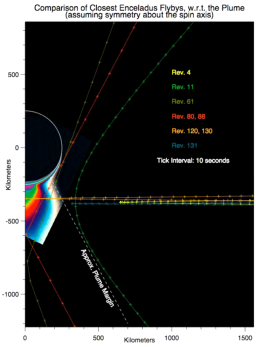Emily Lakdawalla • Oct 08, 2008
Cassini flies within 25 kilometers of Enceladus tomorrow
Hot on the heels of MESSENGER's flyby of Mercury comes another big event, the closest-ever flyby of Enceladus by Cassini. This one is at an altitude of only 25 kilometers, or 16 miles. That's a low flyby! It's half the altitude of any previous Enceladus flyby. Moreover, it's 20 times closer than Cassini has ever got to any other target (it's done flybys of Hyperion, Dione, and Rhea at altitudes of about 500 kilometers), and 40 times closer than it's ever gotten to Titan (the atmosphere prevents Cassini from getting any closer than 950 kilometers from Titan).

Cassini's close flybys of Enceladus
During the prime and extended missions, Cassini will have a total of eight very close flybys of Enceladus. This graph compares their geometry. The Rev 4, 120, 130, and 131 encounters happen when Cassini is on a near-equatorial orbit about Saturn; the other encounters happen with Cassini on more inclined orbits.Rev 3: March 9, 2005, 1,264 km (not pictured)
ev 4: March 9, 2005, 500 km
ev 11: July 14, 2005, 168 km
ev 61: March 12, 2008, 52 km
ev 80: August 11, 2008, 54 kmRev 88: October 9, 2008, 25 km (current encounter)
ev 91: October 31, 2008, 197 km (not pictured)
ev 120: November 2, 2009, 103 km
ev 121: November 21, 2009, 1,607 km (not pictured)
ev 130: April 28, 2010, 103 km
ev. 131: May 18, 2010, 201 km
The press release associated with this flyby included some tantalizing new bits of information learned during the August flyby:
These two flybys might augment findings from the most recent Enceladus flyby, which hint at possible changes associated with the icy moon. Cassini's Aug. 11 encounter with Enceladus showed temperatures over one of the tiger-stripe fractures were lower than those measured in earlier flybys. The fracture, called Damascus Sulcus, was about 160 to 167 Kelvin (minus 171 to minus 159 degrees Fahrenheit), below the 180 Kelvin (minus 136 degrees Fahrenheit) reported from a flyby in March of this year."We don't know yet if this is due to a real cooling of this tiger stripe, or to the fact that we were looking much closer, at a relatively small area, and might have missed the warmest spot," said John Spencer, Cassini scientist on the composite infrared spectrometer.
Here's a timeline for tomorrow's Enceladus flyby.
| Date/ Time (UTC) | Enceladus-88 flyby (October 9, 2008) |
|---|---|
| Event | |
| Oct 9 02:15:00 | Inbound Enceladus plume & neutral gas observations (ISS, UVIS prime) As Cassini approaches over Enceladus' northern hemisphere, it will study the plumes, which should be fainly visible off the nightside limb. The observation lasts 4.25 hours. |
| 07:15:00 | Turn to Earth and downlink data Cassini will clear its recorders in preparation for the flyby. |
| 10:30:40 | RADAR Scatterometry The radio dish will be pointed at Enceladus, actively broadcasting, and listening for the echo; the data addresses questions about Enceladus' surface texture. |
| 14:06:40 | Optical remote sensing (CIRS prime) CIRS will alternately scan across and stare at the north polar region. |
| 17:06:40 | Optical remote sensing (UVIS prime) UVIS will search for neutral gases around Enceladus with a long, slow scan beginning off of the moon and ending on the disk. |
| 18:07:40 | Fields and particles measurements From an hour before closest approach, the pointing will be controlled by the Ion and Neutral Mass Spectrometer, which will be making direct measurements of the composition of the south polar plumes. These will be the best measurements of Enceladus' plume composition to date. The other fields and particles instruments -- the dust analyzer, plasma spectrometer, and magnetometer -- will ride along. The magnetometer will be searching for an induced magnetic field, which may be present if Enceladus has a subsurface ocean. The optical remote sensing instruments will therefore be pointed away from Enceladus through this period. |
| 19:06:40 | Closest approach (altitude 25 km, speed 17.7 km/s, 28°S, 97°W ) |
| 19:07:09 | Cassini flies over south pole (altitude 339 km) |
| 19:21:40 | Optical remote sensing (ISS prime) 15 minutes after closest approach, the cameras will turn back to Enceladus, capturing a multispectral mosaic of the south pole. |
| 19:49:40 | Optical remote sensing (CIRS prime) CIRS will focus on the south pole as Enceladus enters Saturn's shadow, seeing how quickly its surface temperatures fall with the loss of sunlight, and studying the heat flowing from the south polar vents. |
| 19:52:40 | Enceladus enters Saturn's shadow Enceladus will remain in eclipse for 2.5 hours. |
| 20:57:40 | Optical remote sensing (UVIS prime) UVIS will continue its campaign to map the neutral oxygen around Enceladus, and Cassini will then turn to Tethys. |
The Time is Now.
As a Planetary Defender, you’re part of our mission to decrease the risk of Earth being hit by an asteroid or comet.
Donate Today

 Explore Worlds
Explore Worlds Find Life
Find Life Defend Earth
Defend Earth

